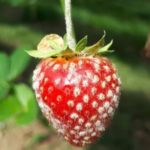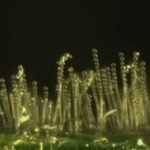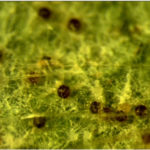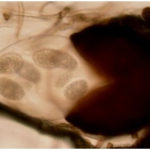.
Condición fitosanitaria: Presente
Grupo de cultivos: Hortícolas
Especie hospedante: Frutilla (Fragaria × ananassa (Weston) Duchesne ex Rozier)
Rango de hospedantes: Asteracea, Cucurbitaceae, Lamiaceae, Scrophulariaceae, Solanaceae, Verbenaceae.
Etiología: Hongo. Biotrófico
Agente causal: Podosphaera aphanis (Wallr.) U. Braun & S. Takam. 2000, syn Sphaerotheca aphanis
Taxonomía: Fungi > Dikarya > Ascomycota > Pezizomycotina > Leotiomycetes > Erysiphales > Erysiphaceae> Podosphaera
.
.
.
.
Sintomatología
Ataca al cultivo de frutilla, tanto en el estado vegetativo como en el reproductivo, en el cual provoca la deformación de los frutos. En ambos casos se manifiesta como una eflorescencia blanquecina, constituida por el micelio y las estructuras reproductivas del hongo, que se extienden sobre los órganos atacados del hospedero. En las primeras etapas del cultivo puede aparecer micelio desarrollándose en el envés de las hojas en un primer estadio de la enfermedad. Con infecciones severas la hoja puede estar cubierta en su totalidad por un polvo blanco. En algunos cultivares los micelios son muy pequeños y es difícil ver manchas blancas. En su lugar aparecen puntos necróticos amarillos a negros que también aparecen en el haz. Los bordes de las hojas seriamente afectadas pueden aparecer rizados hacia arriba. Infecciones foliares severas pueden causar defoliación.
.
.
- Autor: University of Hertfordshire
- Cadenas de conidios sobre conidióforos. Estos son responsables de la apariencia polvorienta. Las esporas se forman en la parte inferior de la cadena, por lo que las esporas más viejas están en la punta de la cadena. Se rompen con las corrientes de viento y pueden viajar distancias cortas, generalmente menos de 100 metros. Autor: David Gadoury, Cornell University
- Cadena de conidios. Fuente: Plant Parasites of Europe
- Los cleistotecios son las estructuras de supervivencia del patógeno. Están firmemente incrustados en micelio en la superficie de la hoja. Autor: David Gadoury, Cornell University
- Cleistotecio con ascos que contienen ascosporas. El cleistotecio se hincha cuando se recubre con una película de agua y se fractura. El asco es un saco elástico que continúa absorbiendo agua y se hincha, eventualmente estallando y expulsando las ascosporas al aire. Los apéndices del género Podosphaera son simples con puntas no ramificadas, y los cleistotecios contienen solo un asco.. Autor: David Gadoury, Cornell University
.
.
* Humedad relativa moderada a alta
* Temperaturas entre 20 y 25 ºC
* Días soleados (lluvia o rocío detienen el crecimiento del hongo)
.
.
Bibliografía
Amsalem L, Freeman S, Rav-David D, et al. (2006) Effect of climatic factors on powdery mildew caused by Sphaerotheca macularis f. sp. fragariae on strawberry. Eur. J. Plant Pathol. 114: 283–292. doi: 10.1007/s10658-005-5804-6
Asalf B, Gadoury DM, Tronsmo AM (2014) Ontogenic resistance of leaves and fruit, and how leaf folding influences the distribution of powdery mildew on strawberry plants colonized by Podosphaera aphanis. Phytopathology 104: 954–963. doi: 10.1094/PHYTO-12-13-0345-R
Berrie AM, Burgess CM (1997) The effect of post-harvest epidemics of powdery mildew on yield and growth of strawberry cv. Elsanta. Proc. Third Strawb. Symp. Acta Hortic. 439: 791–798. doi: 10.17660/ActaHortic.1997.439.131
Carisse O, Maas J (2005) Les maladies du fraisier. In Our Strawberries/Les Fraises de Chez Nous; Khanizadeh, S., DeEll, J., Eds.; Gouvernement du Canada, Les éditions et Services de dépôt: Ottawa, ON, Canada. p. 551. ISBN 0660623382. Link
Carisse O, Bouchard J (2010) Age-related susceptibility of strawberry leaves and berries to infection by Podosphaera aphanis. Crop Protection 9: 969-978. doi: 10.1016/j.cropro.2010.03.008
Carisse O, Lefebvre A, Van der Heyden H, et al. (2013) Analysis of incidence–severity relationships for strawberry powdery mildew as influenced by cultivar, cultivar type, and production systems. Plant Disease 97: 354–362. doi: 10.1094/PDIS-05-12-0508-RE
Carisse O, Morissette-Thomas V, Van der Heyden H (2013) Lagged association between powdery mildew leaf severity, airborne inoculum, weather, and crop losses in strawberry. Phytopathology 103(8): 811-21. doi: 10.1094/PHYTO-11-12-0300-R
Carisse O, Fall ML (2021) Decision Trees to Forecast Risks of Strawberry Powdery Mildew Caused by Podosphaera aphanis. Agriculture 11(1): 29. doi: 10.3390/agriculture11010029
Gadoury DM, Stensvand A, Seem RC, Heidenreich C (2007) Ontogenic resistance of leaves, leaf folding and the distribution of mildew colonies in strawberry powdery mildew (Podosphaera macularis). Phytopathology 97:S38. doi: 10.1094/PHYTO-12-13-0345-R
Gadoury DM, Asalf B, Heidenreich MC, et al. (2010) Initiation, development, and survival of cleistothecia of Podosphaera aphanis and their role in the epidemiology of strawberry powdery mildew. Phytopathology 100: 246-251. doi: 10.1094/PHYTO-100-3-0246
Heaven T, Cockerton HM, Xu X, et al. (2023) A Genomic Resource for the Strawberry Powdery Mildew Pathogen Podosphaera aphanis. Phytopathology: PHYTO03220091A. doi: 10.1094/PHYTO-03-22-0091-A
Mello PP, Onofre RB, Rea M, et al. (2022) Design, Construction, and Evaluation of Equipment for Nighttime Applications of UV-C for Management of Strawberry Powdery Mildew in Florida and California. Plant Health Progress 23: 321-327. doi: 10.1094/PHP-01-22-0002-RS
Onofre RB, Gadoury DM, Peres NA (2021) High Efficacy and Low Risk of Phytotoxicity of Sulfur in the Suppression of Strawberry Powdery Mildew. Plant Health Progress 22: 101-107. doi: 10.1094/PHP-04-20-0034-RS
Sombardier A, Savary S, Blancard D, et al. (2009) Effects of leaf surface and temperature on monocyclic processes in Podosphaera aphanis, causing powdery mildew of strawberry. Can. J. Plant Pathol. 31: 439–448. doi: 10.1080/07060660909507618
Sombardier A, Dufour MC, Blancard D, Corio-Costet MF (2010) Sensitivity of Podosphaera aphanis isolates to DMI fungicides: distribution and reduced cross-sensitivity. Pest Manag Sci. 66(1): 35-43. doi: 10.1002/ps.1827




